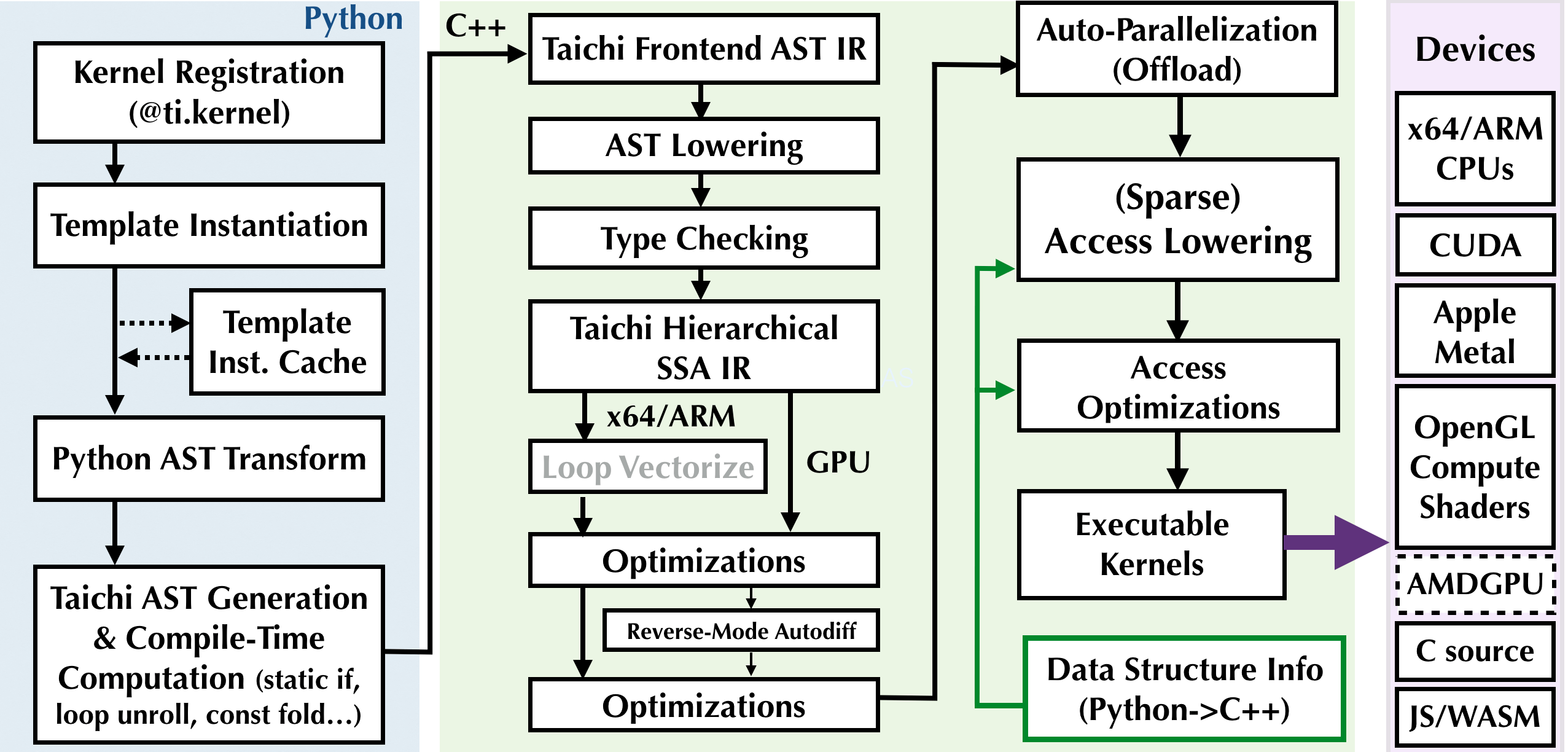Life of a Taichi Kernel
Sometimes it is helpful to understand the life cycle of a Taichi kernel. In short, compilation will only happen on the first invocation of an instance of a kernel.
The life cycle of a Taichi kernel has the following stages:
- Kernel registration
- Template instantiation and caching
- Python AST transforms
- Taichi IR compilation, optimization, and executable generation
- Launching

Let's consider the following simple kernel:
@ti.kernel
def add(field: ti.template(), delta: ti.i32):
for i in field:
field[i] += delta
We allocate two 1D fields to simplify discussion:
x = ti.field(dtype=ti.f32, shape=128)
y = ti.field(dtype=ti.f32, shape=16)
Kernel registration
When the ti.kernel decorator is executed, a kernel named add is registered. Specifically, the Python Abstract Syntax Tree (AST) of the add function will be memorized. No compilation will happen until the first invocation of add.
Template instantiation and caching
add(x, 42)
When add is called for the first time, the Taichi frontend compiler will instantiate the kernel.
When you have a second call with the same template signature (explained later), e.g.,
add(x, 1)
Taichi will directly reuse the previously compiled binary.
Arguments hinted with ti.template() are template arguments, and will incur template instantiation. For example,
add(y, 42)
will lead to a new instantiation of add.
note
Template signatures are what distinguish different instantiations of a kernel template. The signature of add(x, 42) is (x, ti.i32), which is the same as that of add(x, 1). Therefore, the latter can reuse the previously compiled binary. The signature of add(y, 42) is (y, ti.i32), a different value from the previous signature, hence a new kernel will be instantiated and compiled.
note
Many basic operations in the Taichi standard library are implemented using Taichi kernels using metaprogramming tricks. Invoking them will incur implicit kernel instantiations.
Examples include x.to_numpy() and y.from_torch(torch_tensor). When you invoke these functions, you will see kernel instantiations, as Taichi kernels will be generated to offload the hard work to multiple CPU cores/GPUs.
As mentioned before, the second time you call the same operation, the cached compiled kernel will be reused and no further compilation is needed.
Code transformation and optimizations
When a new instantiation happens, the Taichi frontend compiler (i.e., the ASTTransformer Python class) will transform the kernel body AST into a Python script, which, when executed, emits a Taichi frontend AST. Basically, some patches are applied to the Python AST so that the Taichi frontend can recognize it.
The Taichi AST lowering pass translates Taichi frontend IR into hierarchical static single assignment (SSA) IR, which allows a series of further IR passes to happen, such as
- Loop vectorization
- Type inference and checking
- General simplifications such as common subexpression elimination (CSE), dead instruction elimination (DIE), constant folding, and store forwarding
- Access lowering
- Data access optimizations
- Reverse-mode automatic differentiation (if using differentiable programming)
- Parallelization and offloading
- Atomic operation demotion
The just-in-time (JIT) compilation engine
Finally, the optimized SSA IR is fed into backend compilers such as LLVM or Apple Metal/OpenGL shader compilers. The backend compilers then generate high-performance executable CPU/GPU programs.
Kernel launching
Taichi kernels will be ultimately launched as multi-threaded CPU tasks or GPU kernels.